Despite tremendous advances over the last decade in understanding Oregon’s nearshore species and habitats, as well as advances in ODFW’s program capacity to conduct nearshore research and monitoring (ODFW 2012e), there is still a need to enhance and augment existing nearshore programs. Nearshore resources are still poorly understood, relative to the state’s other natural resources. Yet, the demands for information and data for conservation and management purposes continue to grow. Biological, physical, and socioeconomic data collected from research and monitoring efforts are central to effective wildlife conservation and management programs, and provide the information needed for effective outreach and education. The conservation values of a well-informed public help drive policy and management decisions that ensure a heathy ecosystem.
ODFW’s current marine research and monitoring program capacity is diverse, and obtains data on a range of both ecological and fishery questions. The broad suite of research and monitoring projects currently conducted by ODFW help support management decisions and also provide a better understanding of the nearshore environment’s inhabitants and their habitats. This chapter includes information on existing ODFW research and monitoring efforts (to provide context) and some detail on additional research and monitoring needs. This chapter provides a foundation for many of the Recommendations.
Existing ODFW Research and Monitoring Capacity
The list below highlights existing ODFW research and monitoring efforts, along with specific project goals and outcomes.
Shellfish and Estuary Habitat
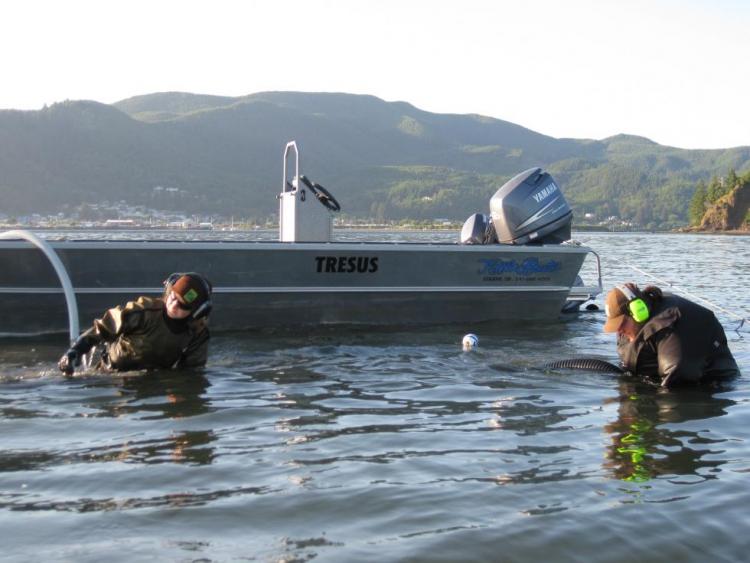
The Shellfish Program conducts research, monitoring and management of marine and estuarine shellfish species, along with the habitats these species utilize. This includes surveys for multiple species of sport and commercially harvested shellfish including, bay clams, Dungeness crab, red rock crab, red sea urchins and razor clams. The shellfish program conducts shoreline creel surveys to monitor the levels of sport harvest. Data from these creel surveys are coupled with counts of the sport harvesters to develop estimates of the overall effort expended by the recreational shellfishers. The ODFW shellfish program also collects measurements of the biological characteristics of the clams and crab. Information generated by the monitoring work is used to gauge the level of seasonal harvest activity and periodically evaluate the need for any modifications of the shellfish harvest regulations. The Shellfish and Estuarine Assessment of Coastal Oregon (SEACOR) project conducts clam population assessments and estuarine habitat studies throughout estuaries along the Oregon coast. Data collected through this project is used to better manage the commercial and recreational clam fisheries, along with informing shellfish stock assessments and tracking estuarine habitat changes. Since its inception in 2008, the SEACOR project has collected data from six major estuaries, with the goal of assessing every major estuary and bay along the Oregon coast. SEACOR has also digitized historical habitat survey information as a component of developing predictive capabilities for shellfish resources within Oregon estuaries.
Marine Habitat
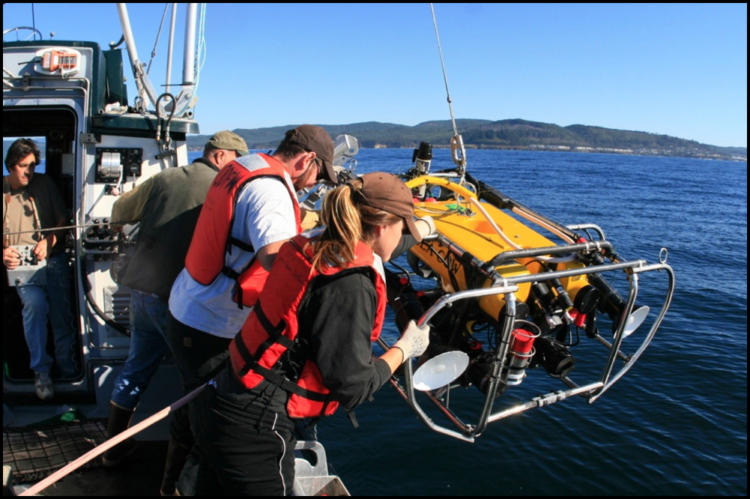
The Marine Habitat Project conducts numerous ecological research projects focused on marine species-habitat relationships. This work helps provide a scientific understanding of the nearshore ecosystem for both fishery and non-fishery species. This project conducted some of the first detailed mapping efforts for Oregon’s nearshore habitat using advanced sonar technologies. This effort has since been expanded by Oregon State University and others, which has resulted in mapping of approximately half of the Oregon Territorial Sea. This spatial data represents a dramatic improvement in the knowledge of seafloor habitats in the nearshore and will have significant applications to resource management. Additionally, the marine habitat project has been instrumental in documenting and monitoring the ecological consequences of nearshore hypoxic zones off of Oregon. This project has also led research efforts on aerial surveys of kelp forests, trawl impacts on soft bottom habitats and annual monitoring of rocky reef biological communities.
Marine Mammals – Pinnipeds
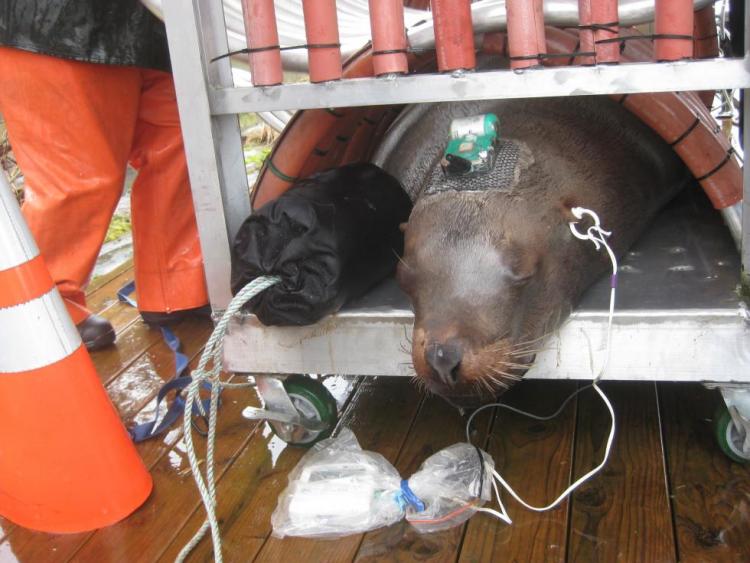
The ODFW provides regional leadership on research and monitoring of seals and sea lions. Ongoing ODFW population monitoring has documented the recovery of seals and sea lions in Oregon since the passage of the federal Marine Mammal Protection Act in the 1970s. The Marine Mammal Program has conducted research on the population status and reproductive output of Oregon’s Steller sea lion population, contributing to the recent de-listing of this species from the federal Endangered Species Act. The program has conducted important studies on the food habits and foraging behavior of seals and sea lions and how their predation impacts to fish species of conservation concern such as ESA-listed salmon and steelhead, white sturgeon and Pacific lamprey.
Marine Reserves Ecological and Human Dimensions
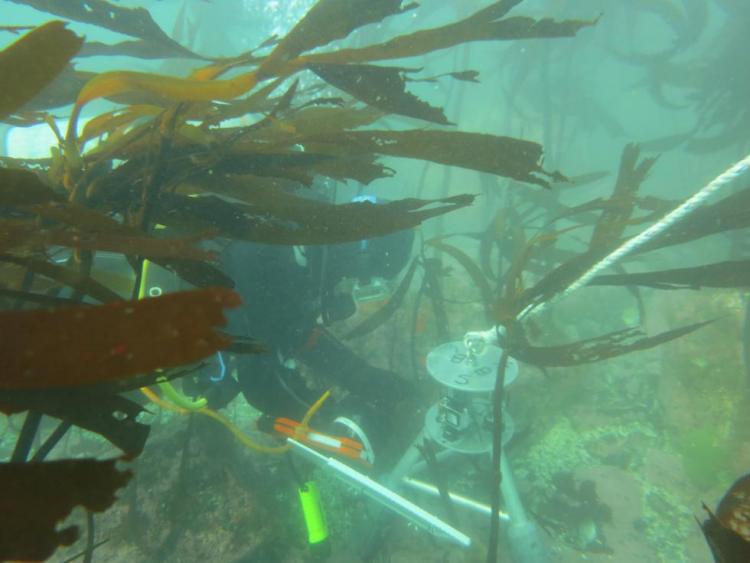
In 2012, Oregon completed designation of five marine reserve sites, which are areas in coastal waters dedicated to conservation and scientific research. The ODFW Marine Reserves Program has begun an ongoing monitoring effort designed to understand the effects of marine reserves on the marine environment and on people. This information will be used to evaluate marine reserves as a management tool in the future. There are two research projects within the marine reserves program: ecological research and human dimensions scientific research. The ecological monitoring project is focused on habitat characterization, oceanography, species that exist at each marine reserve site, and determining whether or not prohibiting extractive activities changes the environment over time. Marine reserve human dimensions monitoring is focused on determining social, cultural and economic changes for ocean users and communities that result from marine reserves implementation. In addition to providing insight on the specific effects of marine reserves, the monitoring effort is proving to be a vital resource in augmenting the general understanding of Oregon’s nearshore environment, coastal economy and ocean users.
Fishery Sustainability Research
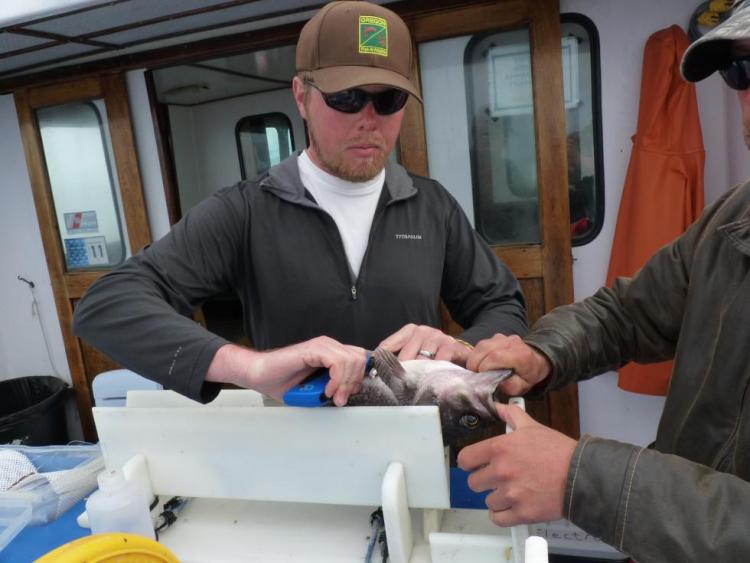
Fishery-related research supports fishery management and assessment of fish stock health. Over the past decade, this program’s research has led the way towards understanding and reducing bycatch. One notable example is with the pink shrimp fishery and the reduction of eulachon bycatch (listed as a threatened species under the federal Endangered Species Act). This work was instrumental both in allowing the continuation of this important fishery while addressing conservation concerns for eulachon, and in contributing toward certification of the Oregon pink shrimp fishery by the Marine Stewardship Council as a sustainable fishery. Additionally, this program conducted extensive research to understand the effects of barotrauma on rockfish and how to reduce barotrauma-related mortality in rockfish. The research resulted in the development and acceptance of rockfish descender devices. Fishery managers use the survival rates to improve estimates of fishing impacts on sensitive species such as yelloweye rockfish. These improved estimates meant increased fishing opportunity for anglers, while still addressing the conservation concerns for the sensitive species.
Fishery managers require information on the population status of harvested species in order to make well-informed management decisions. While the federal government conducts stock assessments on federally managed species, including many ocean fishery species included in the Strategy Species list, there remain a number of state-managed species for which there is incomplete knowledge of population status. ODFW’s fishery-related research program develops species life history information such as population age composition and age of female fish maturity for poorly-understood species, including both federally and state managed species. Federal stock assessment scientists use this information to improve their understanding of population status. The fishery-related research program is currently testing visual survey tools to directly assess the population of nearshore rocky reef fish species, which are not well represented in federally-sponsored species surveys. These studies will help ODFW develop more consistent, accurate and sustainable harvest recommendations.
Fishery Monitoring

Fishery monitoring and sampling are integral in generating data and information to meet the needs of resource managers and ensuring sustainable fisheries. Approximately 40 percent of the ODFW Marine Resource Program’s budget is devoted to a sophisticated sampling program that monitors both commercial and sport fisheries along the Oregon coast. These programs collect information on groundfish, halibut, salmon and albacore tuna fisheries, including catch composition and biological data. Fishery data processing and quality control are also a significant component of the fishery monitoring program. The information collected via this program is used to monitor progress toward quotas, to inform stock assessments, and to assist in the development of management recommendations for the best use of Oregon’s fishery resources.
Research and Monitoring Needs
The subsequent section highlights significant data gaps for the nearshore ecosystem and gives examples of research needed to fill these gaps. While not comprehensive, these examples – if addressed and the data gaps filled – would provide a much deeper understanding of nearshore ecosystem function and status.
General information needs include: baseline data on the distribution and abundance of nearshore species and habitats, data on inter-species and species-habitat associations to understand the nuances of nearshore ecosystem function, and issue-specific data on the effects human activities on nearshore resources.
In particular, the effects of climate change and ocean acidification on species and their habitats need to be understood and considered in conservation decisions. Universities, government agencies and private entities have begun developing programs to observe and monitor the symptoms of climate change. Future needs include designing further studies that can identify and quantify the impacts of those symptoms on species, habitats, and ecosystem function; to explore what changes in nearshore resource distribution, abundance, and interactions we can expect with changing climate patterns anticipated in years to come.
Species Data
Information on the presence, abundance, and location of some nearshore species and biological communities is needed. While we have an understanding of the types of species present in the nearshore area and have limited abundance information on some, we lack the following important information for many species:
- invertebrate and fish community structure of nearshore reefs, and variation in communities among reefs
- identification of indicator species that can be tracked to monitor the health of the system and impacts of climate change
- absolute abundance measures or fishery-independent relative abundance measures for key managed species, and/or indicators of changes in abundance (important for fished species such as nearshore rockfish, cabezon, and greenling, etc.)
- movements undertaken by nearshore species
Specific types of research that can help fill these data gaps include:
- surveys for marine fish, invertebrates, and algae, which are independent of fisheries and at coastwide or other appropriate scales
- periodic and consistent long-term monitoring of organisms at selected indicator sites, such as the ecosystem monitoring currently conducted in marine reserves and nearby comparison areas by ODFW’s Marine Reserves Program, and the selection of specific sites and organisms most likely to demonstrate impacts of climate change
- developing and testing abundance measures or population trend indicators for selected species and monitoring those species over time
Habitat Data
Habitat data include structure and composition of the seafloor, estuary bottoms, and rocky and sandy shore substrates; oceanographic patterns and process (see Oceanographic Data below); and biological communities present (see Species Data above). Our knowledge of nearshore subtidal habitat is improving. We now have considerably more detailed seafloor maps for roughly half of Oregon’s Territorial Sea than we had a decade ago; however, almost half remains to be mapped in detail. Researchers have only begun to understand which characteristics of habitats are most important in addressing the needs of particular species or communities. Types of research that can help fill these data gaps include:
- examining the relationships between species/communities and habitats to determine the most important habitat features to survey
- large-scale, coastwide survey of seafloor structure and composition employing modern ocean survey methodologies
- detailed surveys of selected areas to support studies of species-habitat relationships (see recommendation 7)
Oceanographic Data
Marine organisms are intimately tied to the physical/chemical properties and movements of the ocean waters in which they live. In order to understand the nearshore system we need more information on:
- large and small scale processes determining local water properties
- water movement and circulation patterns on large and small scales of time and space
- natural variation in oceanographic conditions over short and long time scales
- models with proven predictive ability on short and long time scales
- how local Oregon ocean conditions are tied to global ocean and climate conditions, and how global processes such as climate change and ocean acidification are likely to affect local conditions in Oregon’s nearshore waters
Researchers at universities and other research institutions continue to make significant progress toward understanding nearshore oceanographic patterns and ecological processes in the waters off Oregon. Continuation of this research is essential to gaining a better understanding of the nearshore ecosystem.
Ecosystem Data
This includes the data types described above, stitched together to provide an understanding of the interactions and dependencies among species and the relationships between species and their habitats, to provide insight into the functioning of the nearshore ecosystem. This is a growing field and still data-poor; information needed to improve this understanding includes:
- habitat characteristics that determine community structure
- relationships among species, habitats, and oceanographic variables
- how ocean currents affect larval transport and consequently the genetic structure of populations
- connectivity and relationship between estuary and ocean populations
- factors affecting primary and secondary production
- factors affecting reproduction, recruitment, and natural mortality
- food web relationships and predator-prey dynamics
- natural variability of these and other factors
- climate change impacts on species and habitats related to:
- sea level rise effects
- warming ocean temperatures
- altered weather patterns
- changes in circulation patterns
- changes in species range distribution related to temperature or food requirements
- upwelling and nutrient availability for primary production
- changes in food web dynamics
- ocean acidification and hypoxia
- effects of introduced non-native and invasive species
Most of these represent large scientific questions that cannot be addressed with individual research projects. Understanding these variables has, and will continue, to occur incrementally over time. The best way to ensure progress is to continue building Oregon’s research infrastructure and increasing the emphasis on nearshore research. Recent ecosystem modeling efforts have provided insights but still need data both to make predictions and to validate the accuracy of those predictions.
Human Dimensions
Human presence and activities are integral parts of Oregon’s nearshore ecosystem. Human dimensions – or socioeconomic – information can be used to understand how coastal communities, economies, and nearshore resources are interrelated and might be affected by various management actions. Basic economic data concerning commercial fisheries are developed regularly; however, there is less information on recreational fisheries, natural resource contributions to the tourist industry, and the economic consequences of management actions. These and other studies are needed to ensure managers address human dimensions factors in decision-making.
Human Development & Impacts
Several existing and emerging human uses of the nearshore environment will require special studies to understand their effects on nearshore resources and to develop appropriate management measures. Existing human development uses of the nearshore include maritime infrastructure, shoreline armoring, dredging and dredge material disposal, and other marine and/or estuarine construction projects. Examples of possible emerging uses include wave and wind energy development, methane hydrate mining, marine algae harvest, and aquaculture. There has been considerable interest in renewable energy projects off the Oregon coast over the last decade, with an interest in finding solutions to our nation’s energy needs. While the benefit of efficient alternative energy is clear, more research and monitoring (once projects are built) is needed to understand the potential and/or realized impacts of such development. Ballast water from shipping, aquaculture and recreational boating have contributed to the introduction of non-native and invasive species to Oregon’s nearshore. Once established in Oregon, these species are difficult to remove, so prevention of introductions is a preferable approach. An important data need is how best to effectively prevent or mitigate the effects of such species introductions.
Conclusion
As demonstrated above, there are considerably more data gaps than can be filled by any one group or organization. Research and monitoring must be prioritized to address the most pressing needs first. It also is important to develop conservation, research and monitoring partnerships with the commercial and recreational fishing industries, other state and federal agencies, universities, and appropriate non-governmental organizations to maximize the effectiveness and efficiency of the work. ODFW continues to work with partners to address conservation, research and monitoring needs for Nearshore Strategy Species (see Table 5.1).